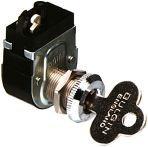Usability for Nerds/The design of a button should reflect its importance
The buttons on a control panel or keyboard should be arranged so that the buttons that are used most often are big and have the most prominent positions, while buttons that are seldom used may be smaller and put away in a corner. Buttons that are used for basic setup and configuration may be put away under a lid, so that people know that these are not for everyday use.
On a photocopier, for example, there is just one button that you use all the time, and that is the big green button you press to make a copy. The picture below shows a bad design of a photocopier control panel. The green copy button is no bigger than the other buttons. For this reason, many people press the gray ON/OFF button to the right instead.

There are certain buttons that cause big consequences when you press them. For example the main power switch at a hospital. Such a button should of course not look like just another switch.
This principle is illustrated by the story of Radio X. Radio X is a little non-profit radio station run by uneducated volunteers. New volunteers need to spend time in the sound studio learning how to use all the equipment. Typically, they will play music and say something in the microphones and then mix it together on the mixer. They are told that there is only one button they are not allowed to touch - the one that turns on broadcasting. Nevertheless, it often happened that this button was turned on by accident. The result was that thousands of people could hear the silly things they were saying in the microphones and that another radio station using the same frequency was unable to send.
The solution to this problem was to replace the "on air" switch by a lock with a key. A lock looks very different from all the other buttons and dials. A lock does not say: "This is just another button that you can press to see what it does". It says: "This is restricted access. Turning this key has important consequences". The key was always sitting in the lock, so nothing prevented deliberate abuse. But that never happened again.
What do these different switches signify?







